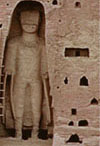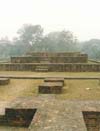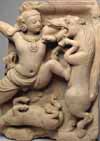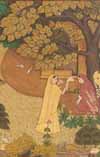|
|
 |
==Bamian
and its huge Buddhas (c.300's-400's?): The town of
Bamian,
in central Afghanistan, becomes one of the great Buddhist centers of
the
world. It is full of remarkable monastic caves, and one hillside niche
that houses perhaps the world's largest statue, a standing Buddha 175
feet
high. (This statue survives until it is destroyed by the Taliban in
2001;
see *kaladarshan*.) [*Routes*] |
 |
==Fa-Hsien
travels in India (394-414), seeking Buddhist texts to translate: The
Chinese
Buddhist monk Fa-Hsien journeys through India and Sri Lanka, visiting
Buddhist
religious sites and collecting texts. One of his favorite places is the
great monastery of Sravasti, near modern Lucknow, where the Buddha
himself
is said to have spent many rainy season retreats. Excerpts from his
account,
"A Record of Buddhistic Kingdoms" (*Brooklyn
College*), make interesting reading; the whole text is also
available
(*Project
Gutenberg*). When he returns to China, he translates a number of
crucial
texts into Chinese, encouraging the further spread of Buddhism there. |
 |
==The
Gupta dynasty (c.321-500) controls most of North India,
and
Kushan power is steadily declining. The dynastic founder Chandragupta
I,
and his successors Chandragupta II and Samudragupta, can claim credit
for
presiding over what many consider to be a great "classical
period"
or even "golden age" of Indian civilization (*the
Gupta-Vakataka age, c.300-550*).
Samudragupta has some
remarkably
lovely coins. [*Routes*] |
 |
==the
early Puranas begin to take shape (c.300's), and the
process
continues for centuries. The eighteen Puranas, full of folkloric
material,
eventually form a kind of bridge from early religious forms into later
devotional practices. The two most famous ones, the "Vishnu Purana" and
the "Bhavavata Purana," both become classics of Krishna-bhakti (*Manas*). |
 |
==Kalidasa
(300's???) is considered the greatest of Sanskrit dramatists, and one
of
the greatest Sanskrit poets as well. But when did he live?? Dates
abound,
and this century is perhaps a plausible possibility; but dates as much
as five or six centuries earlier, and a bit later, have also been
proposed (*wiki*). (Welcome to
the world of Sanskrit dating!) Probably the most famous of
all Kalidasa's works is his classic play "Shakuntala" (*Columbia
Univ.*). |
|
|






